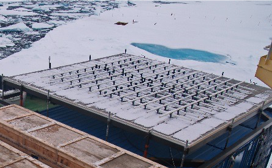Ian Brooks
Wind profile data was obtained by sound detection and ranging (SODAR) which transmit audible sound pulses at several wave lengths. Using the Doppler shift of the return signals and algebra, the wind speed and direction as a function of height, can be estimated. The SODAR is sensitive to water vapor fluctuations (turbulence) and its return signal can therefore also be used to derive information about turbulence in the boundary layer. The SODAR is sensitive to ambient noise and hence was deployed on the ice and only operated during the ice drift.
Download data
Visit web site
Citation
Ian Brooks (2018) SODAR wind profile data from the high-Arctic ASCOS expedition 2008. Dataset version 1. Bolin Centre Database. https://doi.org/10.17043/oden-ascos-2008-sodar-1
References
Tjernström, M. et al. 2014. The Arctic Summer Cloud Ocean Study (ASCOS): overview and experimental design. Atmospheric Chemistry and Physics, 14, 2823–2869. https://doi.org/10.5194/acp-14-2823-2014
Data description
Version 2 of sodar data.
Several files are provided in the archive (see below). Full documentation of variables in provided in a readme file.
All data is provided as matlab structures.
sodar.mat - working copy of sodar data for internal ASCOS use.
may get updated/replaced over time.
See below for contents.
THIS IS THE PRIMARY DATA SET YOU SHOULD USE FOR MOST
APPLICATIONS
FAS.mat - the 'raw' sodar data imported from *.mnd files after
processing by Scintec's black-box FAS code.
No variables have been modified but the timebase has
been adjusted and variables padded with NaNs where
profiles were missing while sodar powered down.
sodar-backscatter--all-profiles.mat
- backscatter profiles only at approx 5-minute intervals
CT2--all-profiles.mat - temperature structure function parameter derived from
backscatter profiles (at ~5 minute intervals)
sodar-matched.mat - variables from other instruments resampled onto sodar
time-height grid.
Comments
Two Doppler wind profilers were used in ASCOS; one radar profiler transmitting at 449MHz and one SODAR (SOund Detection and Ranging) transmitting audible sound pulses at several wave lengths. Both work from the same principles, transmitting beams at an angle to the vertical in different directions. Using the Doppler shift of the return signals and algebra the wind speed and direction can be estimated. Both instruments are phased-array instruments, meaning that there are no moveable parts generating the different beams at different angles; this is instead accomplished electronically.
The 449MHz wind profiler is sensitive to water vapor in the atmosphere and hence has the best results in moist air, and was deployed at the start of the ice drift on top of the port three containers located on the roof of the foredeck lab and operated through the rest of the expedition. Its return signal strength can, in addition to the Doppler information, be used to analyze the vertical structure of the atmosphere but only in a relative sense since the water vapor content is variable.
The SODAR is sensitive to water vapor fluctuations (turbulence) and its return signal can therefore, in addition to the Doppler information, be used to derive information about turbulence in the boundary layer. The SODAR is sensitive to ambient noise and hence was deployed on the ice and only operated during the ice drift.
Original address: http://www.ascos.se/index.php?q=node/389
Files:
sodar-v2.zip (13.39 MB)
